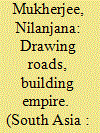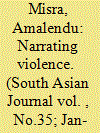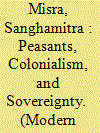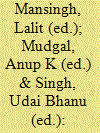|
|
|
Sort Order |
|
|
|
Items / Page
|
|
|
|
|
|
|
| Srl | Item |
| 1 |
ID:
131924


|
|
|
|
|
| Publication |
2014.
|
| Summary/Abstract |
Studies of colonial travel and mobility reveal how spaces are constructed through practices which select and link sites together, drawing fresh itineraries and re-organising places. A series of lithographic sketches published in 1830 as Sketches of the New Road in a Journey from Calcutta to Gyah, drawn by Charles D'Oyly (1781-1845) on his journey from Calcutta to Gaya, captures the tacit colonial imbrication of notions of travel, circulation, landscape and spatial production. An officer posted in various capacities at various places in eastern India in the early part of the nineteenth century, D'Oyly was a prolific amateur painter who sketched and painted different landscapes across the region. His Sketches holds a special significance as his pictures capture and freeze glimpses of a newly-constructed colonial road stretching across the countryside. D'Oyly's plates were intended to celebrate the new colonial circuit as a form of public works, drawing attention away from the urban epicentre of colonial Calcutta. I read this construction as a kind of spatial practice whereby a fresh idea of space emerges through these new operations, supplanting that of pre-colonial India.
|
|
|
|
|
|
|
|
|
|
|
|
|
|
|
|
| 2 |
ID:
183179


|
|
|
|
|
| Summary/Abstract |
This article is based on field research investigating levels of ecoliteracy and associating factors among four tribal groups in Jharkhand and West Bengal, involving 360 respondents from the Lodha, Santhal, Asur and Oraon communities. The study revealed low to extremely high levels of ecoliteracy and identified several specific factors as significant predictors of ecoliteracy levels. While gender, occupation and total monthly income of respondents did not influence such levels, the study conclusively indicates that detachment from forest and natural resources is detrimental to the preservation and cultivation of ecoliteracy and that the connection of people and forests requires careful multidimensional attention.
|
|
|
|
|
|
|
|
|
|
|
|
|
|
|
|
| 3 |
ID:
155922


|
|
|
|
|
| Summary/Abstract |
This article discusses the way in which assemblages of technologies, political institutions, and practices of exchange have rendered both language and script a site for an ongoing politics of authority among Santals, an Austro-Asiatic speaking Adivasi (Scheduled Tribe) community spread throughout eastern India. It focuses particularly on the production of Santali-language print artefacts, which, like its dominant language counterparts, such as Bengali, has its roots in colonial-era Christian missions. However, unlike dominant languages, Santali-language media has been characterized by the use of multiple graphic registers, including a missionary-derived Roman script, Indic scripts such as Devanagari and Eastern Brahmi, and an independently derived script, Ol-Chiki. The article links the history of Santali print and graphic practice with assertions of autonomy in colonial and early post-colonial India. It then ethnographically documents how graphic practices, in particular the use of multiple scripts, and print technologies mediate a contemporary politics of authority along vectors such as class and generation within communities that speak and read Santali in the eastern state of West Bengal, India.
|
|
|
|
|
|
|
|
|
|
|
|
|
|
|
|
| 4 |
ID:
111200


|
|
|
| 5 |
ID:
179922


|
|
|
|
|
| Summary/Abstract |
This article studies two seismic decades in the history of the Garo community, marked out in colonial records as among the most violent and isolated people that British rule encountered in eastern and northeastern India. Through a densely knit historical narrative that hinges on an enquiry into the colonial reordering of the core elements of the regional political economy of eastern and northeastern India, it will train its focus on the figure of the rebellious Garo peasant and on the arresting display of Garo recalcitrance between 1807 and 1820. Reading a rich colonial archive closely and against the grain, the article will depart from extant historiography in its characterization of the colonial state in the early nineteenth century as well as of its relationship with ‘tribes’/‘peasants’ in eastern and northeastern India. A critique of the idea of primitive violence and the production of the ‘tribe’ under conditions of colonial modernity will occupy the latter half of the article. Here it will argue that the numerous and apparently disparate acts of headhunting, raids, plunder, and burning by the Garos on the lowlands of Bengal and Assam were in fact an assembling of the first of a series of sustained peasant rebellions in this part of colonial India—a powerful manifestation of a community's historical consciousness of the loss of its sovereign self under British rule.
|
|
|
|
|
|
|
|
|
|
|
|
|
|
|
|
| 6 |
ID:
164998


|
|
|
|
|
| Publication |
New Delhi, Pentagon Press, 2019.
|
| Description |
xxiii, 359p.hbk
|
| Standard Number |
9789386618641
|
|
|
|
|
|
|
|
|
|
|
|
Copies: C:1/I:0,R:0,Q:0
Circulation
| Accession# | Call# | Current Location | Status | Policy | Location |
| 059619 | 338.9/MAN 059619 | Main | On Shelf | General | |
|
|
|
|
|
|
|
|
|